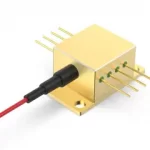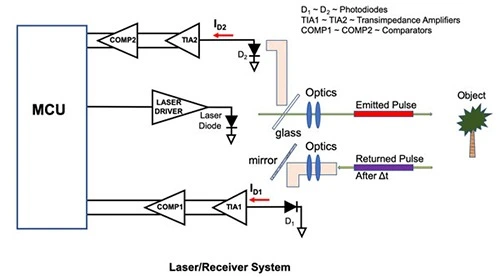
Avalanche photodiodes (APDs)are highly sensitive light detectors that multiply the tiny current from each absorbed photon into a measurable pulse. When an InGaAs/InP APD is biased above its breakdown voltage – so-called Geiger mode – even a single photon can trigger a self-sustaining avalanche of charge carriers. In practice, the device is pulsed above breakdown and then quenched after detection, producing a sharp electrical pulse for each photon. Physically, the diode’s high electric field (often >10^6 V/cm) accelerates a photo‑generated carrier to ionize the semiconductor lattice, “knocking loose” many more carriers in a runaway chain reaction. The result is a gain of 10^6 or more: one absorbed photon yields a nanosecond-scale current pulse that can be directly counted. After the avalanche, the bias is briefly lowered (quenched) and then restored, ready for the next photon.
This Geiger-mode operation – essentially a solid-state photomultiplier – allows true single-photon sensitivity with very low timing jitter. The Lontenoe InGaAs APD is designed for telecom wavelengths (roughly 0.9–1.65 μm), where silicon detectors are blind. InGaAs material extends high quantum efficiency into the near‑infrared, making these APDs ideal for applications at 1310 nm and 1550 nm. In normal (linear) APD use, gain is limited to ~10–50×; in Geiger mode, the gain is effectively infinite for each pulse, providing digital photon-detection outputs. In summary, the Lontenoe InGaAs SPAD (Single‑Photon Avalanche Diode) behaves like a photon-triggered switch: a single photon can initiate a large, fast avalanche pulse, which is then counted by attached electronics.
Key Applications
Single-photon InGaAs APDs are essential tools for modern sensing and communication systems. The Lontenoe device is tailored to fields that demand extreme low-light sensitivity:
- Quantum Communication and Cryptography: Long-distance fiber-optic quantum key distribution (QKD) and quantum networks operate at 1300–1550 nm using single photons. InGaAs SPADs have been the workhorse detectors for these systems. Their ability to count individual telecom-wavelength photons with moderate cooling makes QKD and quantum optics experiments feasible in the lab and field.
- LIDAR/ToF Ranging: Eye-safe LiDAR systems (using 1550 nm pulses) and high-resolution time-of-flight (ToF) rangefinders rely on photon-counting receivers. For example, analog devices explain a typical LiDAR setup: a laser pulse is emitted, reflected by objects, and detected by a fast photodiode (shown below), with the return pulse time yielding distance. InGaAs APDs—especially those with GHz gating or fast quenching—enable long-range, high-repetition-rate LiDAR with single-photon returns. Excelitas notes that its APDs are “suitable for eye-safe laser range-finding and LiDAR systems” at 1550 nm.
3. Fiber and OTDR Sensing: Optical Time-Domain Reflectometry (OTDR) and fiber monitoring use pulsed lasers and APD receivers to map fiber loss and locate faults. Low-noise InGaAs APDs increase the dynamic range and reach of OTDR systems. In fact, Excelitas explicitly lists “Optical time-domain reflectometer (OTDR)” and free-space optical communication among InGaAs APD applications. Similarly, long-distance space–earth optical links and free-space comms at 1550 nm use InGaAs SPADs.
4. Low-Light Scientific Instrumentation: Any application needing to detect extremely weak infrared light benefits from these APDs. Examples include fluorescence lifetime imaging, confocal microscopy, and spectroscopy at NIR wavelengths. InGaAs SPADs enable single-photon sensitivity in these systems. In addition, emerging techniques like time-correlated single-photon counting (TCSPC) and 3D imaging (ToF cameras) use SPAD arrays for high-speed photon timing.
In summary, wherever near-infrared light levels are very low, an InGaAs avalanche detector can pull faint signals above the noise floor. Their compact size, ease of operation, and compatibility with fiber coupling make them practical for field-deployed quantum links, LIDAR units, and telecom maintenance equipment.
InGaAs APD: Features and Specifications – Lontenoe
The Lontenoe InGaAs APD is engineered for high single-photon sensitivity and reliability. Key performance attributes include:
- High Responsivity: ≥8 A/W at 1550 nm. This means each absorbed photon generates a large current pulse. High responsivity ensures more photons are detected and improves signal-to-noise ratio (Excelitas APDs similarly advertise “high responsivity” and large quantum efficiency).
- High Photon Detection Efficiency: ≥20% at 1550 nm. (In practice, PDE is the product of quantum efficiency and avalanche triggering probability.) This is comparable to other InGaAs SPADs, many of which reach ~20–25% PDE.
- Low Dark Current: ≤2 nA (at room temperature, just below breakdown). Low intrinsic leakage means less noise when no light is present. (For comparison, Excelitas APDs typically have dark current ~2–15 nA.)
- Low Dark Count Rate: 500–1500 counts per second (cps) at 1550 nm. This is the rate of spurious avalanches with no light. By cooling the chip to –25°C (typical test) or lower, Lontenoe achieves very low false counts. Note that high-end cooled SPAD modules (e.g. ID Quantique’s ID230) push DCR down to ~50 Hz using –90°C cooling, but Lontenoe’s APD offers low DCR without such extreme cooling.
- Afterpulsing: 1.5–2.5% (prevalence, gated at 1.25 GHz). Afterpulsing is the probability that a detection event leaves trapped charge causing a secondary false count. Lontenoe’s APD has a moderate afterpulse rate, comparable to other InGaAs SPADs in gated operation.
- Wide Wavelength Range: Single-photon detection is achievable from ~950 nm to 1650 nm (covering telecom O, C, and L bands). The InGaAs absorption layer is optimized for 1000–1700 nm, with peak sensitivity around 1550 nm.
- Broad Temperature Range: Operating –40°C to +45°C. The device can be cooled with a TEC (thermoelectric cooler) down to –25°C or even –40°C for best noise performance, or run uncooled at ambient. The wide range enables deployment from cold outdoor environments up to +45°C industrial settings.
- Fast Gating: The APD’s low capacitance supports high-speed gating and short dead time. It can be used with GHz-range gating circuits for picosecond timing and high count rates (similar to advanced InGaAs SPAD systems).
- High Reliability: The diode is made with proven InGaAs/InP fabrication and undergoes burn-in and qualification. The metal-ceramic packages (see below) are hermetic, making the device robust for field use.
These attributes make the Lontenoe APD well-suited for time-resolved single-photon tasks. The combination of high responsivity and low dark noise means more of the incoming photons contribute to the signal, allowing longer range or higher bandwidth operation in LiDAR, as well as longer fiber reach in OTDR.
Packaging and Operation
Lontenoe supplies the APD in two main package styles to suit different system needs. The standard TO-coaxial tail package integrates a small housing with a single-mode fiber pigtail (typically PM fiber) attached. In this configuration, the APD is mounted on a TO-46 header with the fiber bonded directly to the photodiode, yielding a compact, fiber-coupled detector. This is ideal for easy plug-and-play integration into optical systems and benchtop instruments.
For applications demanding the lowest noise, Lontenoe also offers a TEC-cooled butterfly module. This package encloses the APD on a thermoelectric cooler (TEC) chip with a built-in temperature sensor. The butterfly housing (cold-finger style) includes electrical leads for heater control and a fiber output, maintaining the diode at sub-zero temperatures (down to –40°C). Active cooling markedly reduces dark count rate and stabilizes performance. The cooler runs on a small supply (11.9 V, 0.8 A max) and can maintain the device at the set temperature. Despite the TEC, total power draw is relatively low (under 10 W), much less than cryogenic systems, yet provides much of the benefit of cooled operation.
Both package types are hermetic and ESD-protected. Custom packaging is also available on request: for example, different fiber types (single-mode, multi-mode, connectors) or even free-space optical windows. In all cases, the APD’s electrical connections (anode, cathode) are brought out via standard pins on the package. Typical operation uses a negative bias just below breakdown, with fast external quenching and gating electronics (Lontenoe can also supply or recommend quenching circuits).
Key operating parameters for the packaged modules match the chip: breakdown <90 V, biasing at 5–10 V above breakdown for Geiger operation, gate widths down to 0.1 µs, and deadtimes (holdoff) of a few hundred nanoseconds to keep afterpulsing low. The wide temperature tolerance and robust mounting ensure stable operation over –40°C to +45°C ambient.
Comparison with Competing InGaAs APDs
The table below compares the Lontenoe SPAD to representative products from Hamamatsu, Excelitas, and Laser Components. Note that Hamamatsu and Laser Components primarily offer linear-mode APDs, whereas Lontenoe’s device is intended for Geiger-mode photon counting. Still, the key photodiode metrics can be compared:
Comparative Performance
Parameter | Lontenoe InGaAs SPAD | Hamamatsu InGaAs APD(e.g. G14858) | Excelitas C30645 APD | Laser Components IAG APD |
Breakdown Voltage (V) | ≤ 90 V | ~65 V (typical) | ~50 V | 45–55 V |
Responsivity @1550 nm | ≥ 8 A/W | ~0.8 A/W (at unity gain) | ~9.3 A/W | ~0.9 A/W |
Photon Detection Efficiency (PDE) | ≥ 20% (telecom band) | ~20% (with avalanche gain) | ~75% QE | >70% QE |
Dark Current / Dark Count | ≤ 2 nA (bias near Vbr) | ≤ 50 nA (max) | 2.5–15 nA (typ) | 0.3–20 nA (device size dependent) |
Dark Count Rate | 500–1500 cps (at –25°C) | – (not specified) | – | – |
Afterpulsing | ~1.5–2.5% (gated) | not applicable (linear mode) | n/a | n/a |
Operating Temp (°C) | –40 to +45 | –40 to +85 | not specified (typ. TA=22°C) | –40 to +85 |
Cooling | Built-in TEC (optional) | none | none | none |
Packaging | TO-46 fiber-coupled or butterfly (ceramic) | TO-18 (hermetic) | TO-18 / ceramic | TO-46 (hermetic) |
Highlights: Lontenoe’s APD stands out with very high responsivity (≥8 A/W), comparable to or exceeding Excelitas’s 9.3 A/W model. This high gain means more signal per photon, which enables longer range or faster counting with the same light source. At the same time, Lontenoe’s dark current is extremely low (≤2 nA) – much lower than the typical dark currents of large-area APDs – contributing to a low dark count. The integrated thermoelectric cooling (butterfly package) further suppresses DCR, whereas most competitors require external cooling or run uncooled. For instance, ID Quantique’s high-end SPD uses a Stirling cooler down to –90°C to achieve a 50 Hz DCR, while Lontenoe achieves useful low-noise operation with only a small Peltier cooler.
Moreover, the Lontenoe APD can operate on lower power rails: the TEC only needs ~12 V/0.8 A (9.5 W), whereas some SPAD modules draw many tens of watts. The standard fiber pigtail also simplifies integration compared to bare diodes. Finally, Lontenoe offers custom variants (fiber type, connector, etc.) to meet specific integration needs, a flexibility that many canned detectors lack.
Overall, the comparison shows that Lontenoe’s InGaAs SPAD blends the high responsivity and low-noise figures of top InGaAs APDs with the single-photon capability of gated SPADs. System designers can leverage this by achieving single-photon sensitivity without the large overhead of dedicated photon-counting modules – all while maintaining a compact footprint and lower power budget.






